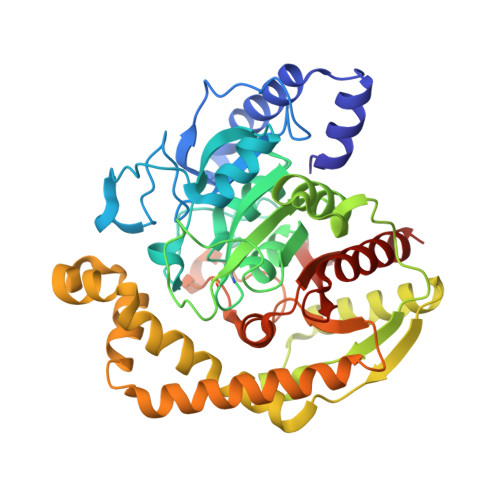Characterization of a Novel Ser-Cisser-Lys Catalytic Triad in Comparison with the Classical Ser-His-Asp Triad
Shin, S., Yun, Y.S., Koo, H.M., Kim, Y.S., Choi, K.Y., Oh, B.-H.(2003) J Biol Chem 278: 24937
- PubMed: 12711609
- DOI: https://doi.org/10.1074/jbc.M302156200
- Primary Citation of Related Structures:
1O9N, 1O9O, 1O9P, 1O9Q, 1OBI, 1OBJ, 1OBK, 1OBL, 1OCH, 1OCK, 1OCL, 1OCM - PubMed Abstract:
Amidase signature family enzymes, which are widespread in nature, contain a newly identified Ser-cisSer-Lys catalytic triad in which the peptide bond between Ser131 and the preceding residue Gly130 is in a cis configuration. In order to characterize the property of the novel triad, we have determined the structures of five mutant malonamidase E2 enzymes that contain a Cys-cisSer-Lys, Ser-cisAla-Lys, or Ser-cisSer-Ala triad or a substitution of Gly130 with alanine. Cysteine cannot replace the role of Ser155 due to a hyper-reactivity of the residue, which results in the modification of the cysteine to cysteinyl sulfinic acid, most likely inside the expression host cells. The lysine residue plays a structural as well as a catalytic role, since the substitution of the residue with alanine disrupts the active site structure completely. The two observations are in sharp contrast with the consequences of the corresponding substitutions in the classical Ser-His-Asp triad. Structural data on the mutant containing the Ser-cisAla-Lys triad convincingly suggest that Ser131 plays an analogous catalytic role as the histidine of the Ser-His-Asp triad. The unusual cis configuration of Ser131 appears essential for the precise contacts of this residue with the other triad residues, as indicated by the near invariance of the preceding glycine residue (Gly130), structural data on the G130A mutant, and by a modeling experiment. The data provide a deep understanding of the role of each residue of the new triad at the atomic level and demonstrate that the new triad is a catalytic device distinctively different from the classical triad or its variants.
Organizational Affiliation:
Center for Biomolecular Recognition, Pohang, Kyungbuk, 790-784, Korea.














